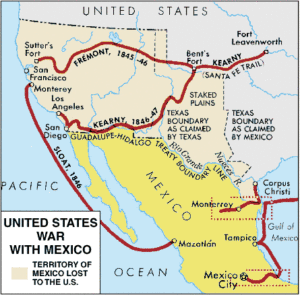None of these things were explained in the Heritage Series 3 book. The Mexican-American War of 1846-1848 got scarcely 3 sentences before the text moved on & spent 3 pages discussing the gold rush of 1849. Not a single mention of the Alamo, or the Texas Revolution, or even Davy Crockett to be seen. While that is just fine for a textbook written with one of its biggest customers, California, in mind – it doesn’t cut it for my standards. So instead, I gave my kids a brief run down of the history.
In order to understand the reasons behind the Mexican-American War, we need to go back to the Texas Revolution, which has its roots in the War for Mexican Independence. PBS has a great resource for all of this here.
In 1821, Mexico gained its independence from Spain, but was flat broke. So they enticed American settlers into the Texas area with promises of tax breaks and land. A few years later, those promises were rescinded, which prompted trouble between the American settlers and the Mexican government. The conflict came broke loose in October 1835. The Texans won, and won often, against Mexican President Santa Ana’s brother-in-law, General Martin Cos. By December 11, 1835, General Cos was forced to surrender and leave Texas. The Texans thought it was over, after all, they had won!
 Davy Crockett arrived in Texas in January 1836. Unlike today’s celebrities (I’m looking at you Alec Baldwin!), Crockett had kept his promise to leave the country if Martin Van Buren was elected President. He signed up with the Texas Militia on the promise of land (he was hoping to bring his family to Texas as soon as he a place for them), and was sent to the Alamo. He arrived at the Alamo on February 8, 1836. 15 days later, Santa Ana surrounded the Alamo, and began his 13-day siege.
Davy Crockett arrived in Texas in January 1836. Unlike today’s celebrities (I’m looking at you Alec Baldwin!), Crockett had kept his promise to leave the country if Martin Van Buren was elected President. He signed up with the Texas Militia on the promise of land (he was hoping to bring his family to Texas as soon as he a place for them), and was sent to the Alamo. He arrived at the Alamo on February 8, 1836. 15 days later, Santa Ana surrounded the Alamo, and began his 13-day siege.
Ultimately Santa Ana killed everyone at the Alamo, except for a handful of women, including Susanna Dickinson, and a slave named Joe. The few that had tried to surrender were executed. Dickinson & Joe were allowed to return to the Americans, to spread the word of Santa Ana’s vast army. Soon after, Santa Ana’s army massacred American forces at Goliad. Instead of instilling fear, as Santa Ana wanted, these actions only served to deepen the resolve of the Texans.
Sam Houston led the Army in the “Runaway Scrape.” Houston knew he needed help, and that the Americans wouldn’t send it. He hoped to draw Santa Ana across the border into Louisiana. If he could get Santa Ana to attack him on American soil, his friends in New Orleans would be able to help him out. The civilians fled in front of Houston’s Army, and Houston burned everything behind him to keep Santa Ana from getting the supplies.
The Texans managed to stay hidden for a long time. Eventually, Santa Ana split his force again, and rode out to look for them. At that point, Houston broke off from his runaway strategy and attacked Santa Ana. Defeated, Santa Ana signed a peace treaty, and was forced to go to Washington DC for his own protection. While he was gone, the Mexican government deposed him & refused to ratify his treaty. They continued to provoke the Texans, who had declared their sovereignty after the treaty was signed.
 The Texans knew they needed help. They appealed to the American government. Finally, after several tries, the United States Congress accepted Texas’s request for statehood in 1845 – an act that triggered the Mexican-American War. The Americans rolled in, and didn’t just kick the Mexicans out of Texas, we took California, Nevada, Arizona, & New Mexico too.
The Texans knew they needed help. They appealed to the American government. Finally, after several tries, the United States Congress accepted Texas’s request for statehood in 1845 – an act that triggered the Mexican-American War. The Americans rolled in, and didn’t just kick the Mexicans out of Texas, we took California, Nevada, Arizona, & New Mexico too.
The Treaty of Guadalupe Hidalgo was signed in February 1948. The Americans had won a decisive victory, and gained a lot of territory for Western Expansion. A short time later, gold was discovered at Sutter’s Fort, and the 1849 Gold Rush was triggered. But that’s for another post.

1 thought on “Mexico’s Independence, Texas Sovereignty, and More War”